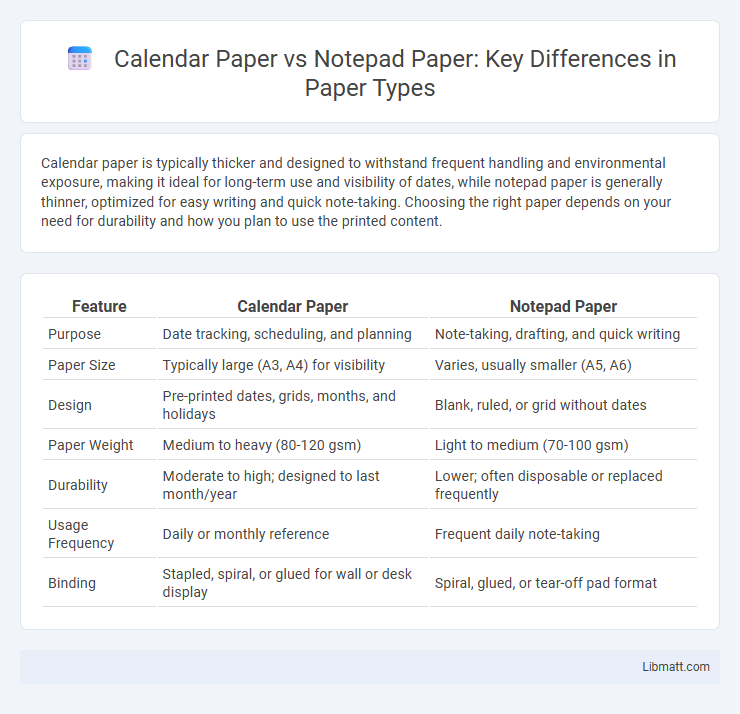Calendar paper is typically thicker and designed to withstand frequent handling and environmental exposure, making it ideal for long-term use and visibility of dates, while notepad paper is generally thinner, optimized for easy writing and quick note-taking. Choosing the right paper depends on your need for durability and how you plan to use the printed content.
Table of Comparison
| Feature | Calendar Paper | Notepad Paper |
|---|---|---|
| Purpose | Date tracking, scheduling, and planning | Note-taking, drafting, and quick writing |
| Paper Size | Typically large (A3, A4) for visibility | Varies, usually smaller (A5, A6) |
| Design | Pre-printed dates, grids, months, and holidays | Blank, ruled, or grid without dates |
| Paper Weight | Medium to heavy (80-120 gsm) | Light to medium (70-100 gsm) |
| Durability | Moderate to high; designed to last month/year | Lower; often disposable or replaced frequently |
| Usage Frequency | Daily or monthly reference | Frequent daily note-taking |
| Binding | Stapled, spiral, or glued for wall or desk display | Spiral, glued, or tear-off pad format |
Understanding Calendar Paper vs Notepad Paper
Calendar paper typically features a glossy or semi-glossy finish with high-quality printing designed to display dates, images, and notes clearly, enhancing durability and visual appeal throughout the year. Notepad paper is usually lightweight, matte, and uncoated, optimized for easy writing and frequent page removal, making it ideal for jotting down quick notes or lists. Understanding these differences helps determine the best paper type based on use case: calendars prioritize longevity and aesthetics, while notepads focus on writing comfort and practicality.
Key Material Differences
Calendar paper typically features a heavier weight and glossy finish designed to showcase vibrant images and withstand frequent handling throughout the year, whereas notepad paper tends to be lighter, matte, and optimized for smooth writing and easy page tearing. Calendar paper often includes a sturdy backing for display purposes, while notepad paper prioritizes flexibility and usability for quick note-taking. The surface coatings on calendar paper enhance image clarity and durability, contrasting with the simpler, more porous texture of notepad paper suited for pencils, pens, or markers.
Surface Texture and Writing Experience
Calendar paper typically features a smooth, coated surface designed to enhance print clarity and durability, which can sometimes cause ink to smudge or dry slowly, affecting the writing experience. Notepad paper usually has a matte, uncoated texture that absorbs ink more quickly, providing a more comfortable and consistent feel for handwriting. The tactile difference between the two surfaces influences pen glide and ink retention, making notepad paper preferable for frequent writing tasks.
Durability and Longevity Comparison
Calendar paper is typically coated and thicker, designed to withstand frequent handling and exposure to sunlight, making it more durable and longer-lasting than standard notepad paper. Notepad paper is often thinner and less resistant to wear, which can lead to quicker tearing, fading, or damage over time. If you need a reliable surface that maintains clarity and strength for months or years, calendar paper is the superior choice for durability and longevity.
Ink Absorption and Compatibility
Calendar paper typically features a coating that enhances ink absorption, preventing smudging and ensuring vibrant, clear prints ideal for visual displays. Notepad paper, often uncoated or lightly coated, offers moderate ink absorption suitable for everyday writing but may cause ink to bleed or feather with certain pens. Choosing calendar paper ensures better ink compatibility for printed graphics, while notepad paper suits your handwriting needs with standard pens and pencils.
Suitability for Different Writing Tools
Calendar paper typically features a smoother, coated surface ideal for pen and pencil use, preventing ink bleed and smudging, while notepad paper often has a more porous texture suitable for everyday ballpoint pens and pencils but less compatible with markers or fountain pens. Your choice depends on the writing tools you prefer; using markers or gel pens on calendar paper will deliver sharper lines, whereas notepad paper may absorb ink faster, causing feathering or ghosting. For precise, clean writing, especially with fine-tipped instruments, calendar paper offers superior performance compared to standard notepad paper.
Aesthetic and Design Considerations
Calendar paper often features vivid colors, seasonal themes, and structured grids to enhance visual appeal and ease of use, making it ideal for monthly planning and display. Notepad paper prioritizes simplicity and flexibility, utilizing clean, minimal designs with lined or blank pages that accommodate diverse writing styles and creative needs. Your choice depends on whether you prefer the decorative, organized layout of calendar paper or the versatile, understated design of notepad paper.
Practical Uses in Daily Life
Calendar paper is designed with durable materials and pre-printed dates, making it ideal for tracking appointments, deadlines, and events in your home or office. Notepad paper offers versatile blank or lined sheets perfect for jotting down quick notes, to-do lists, or brainstorming ideas on the go. Choosing the right paper depends on whether you need structured date management or flexible note-taking for your daily tasks.
Cost and Availability Analysis
Calendar paper typically costs more per sheet due to its specialized coating and printing processes, while notepad paper is generally cheaper and more widely available in bulk. You can find notepad paper easily in various weights and textures from numerous suppliers, whereas calendar paper often requires ordering from niche vendors or printing services. For cost efficiency and accessibility, notepad paper usually presents a better option for everyday use or large-scale projects.
Choosing the Right Paper for Your Needs
Calendar paper typically features durable, heavyweight stock designed to withstand frequent handling and maintain printed images over time, making it ideal for long-term visibility. Notepad paper is generally lighter and more affordable, optimized for easy writing and quick note-taking without the need for enhanced durability. You should select calendar paper for presentations or displays that require lasting quality, while notepad paper suits everyday use and portability.
calendar paper vs notepad paper Infographic

 libmatt.com
libmatt.com